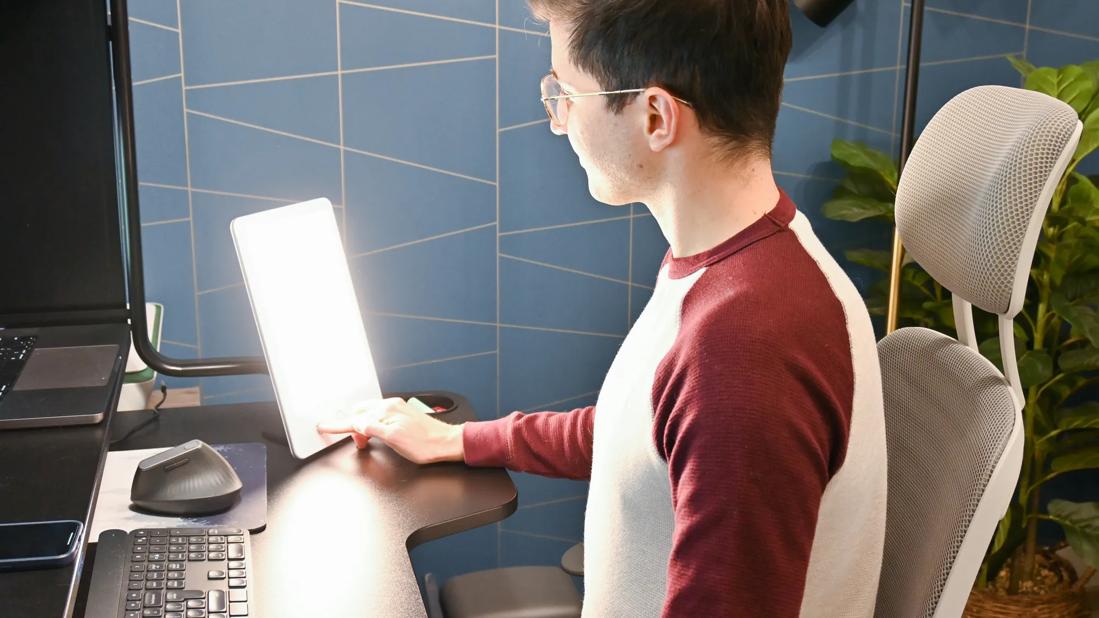Light therapy can boost sleep and help fight depression

The dark, cold winter months can take a toll on mental health. If you’re sleeping too much, feeling depressed or have your days and nights mixed up during the winter, you might want to consider using a sun lamp.
Advertisement
Cleveland Clinic is a non-profit academic medical center. Advertising on our site helps support our mission. We do not endorse non-Cleveland Clinic products or services. Policy
The light delivered through a sun lamp is often particularly effective for people with seasonal affective disorder (SAD), according to family medicine practitioner Robert Cain, MD.
“Long periods of dark and a lack of sun exposure get your sleep-wake rhythm thrown off and sun lamps help reset it,” says Dr. Cain.
So, should you use a sun lamp for depression? Dr. Cain explains how one may help with SAD and other medical conditions.
A sun lamp is a device that mimics natural light. It may also be called a SAD lamp, a light therapy box or a light box, and might be referred to as light therapy or bright light therapy.
One benefit of a sun lamp? No prescription is necessary for it. Sun lamps are available at many retail stores and online retailers for a variety of different price points.
“Any doctor who treats depression — a primary care provider, psychiatrist or psychologist — can recommend light therapy, but you don’t need a prescription to buy a sun lamp,” shares Dr. Cain.
When it comes to using a sun lamp for seasonal depression, one study reports that bright-light therapy is now considered to be the first line of treatment for SAD.
Sun lamps positively impact your body’s regulation of melatonin, a hormone that helps manage your sleep-wake cycle, as well as serotonin, which helps regulate your mood by relaying signals in your brain.
Advertisement
“By restoring the natural day-night (circadian) rhythm to our system, bright light therapy lamps reduce melatonin production and improve serotonin production,” explains Dr. Cain. “The end result is often a significant improvement in normal sleep patterns and mood.”
Sun lamps may also improve:
If you have bipolar disorder, Dr. Cain recommends using a mood stabilizer with a sun lamp because the added light exposure can cause a manic episode.
Yes, sun lamp treatment does work. In fact, it’s common to see improvement in your mood within two to four days if you use a 10,000-lux bulb for about 30 minutes every morning.
“Light therapy via sun lamps is most effective in the mornings,” says Dr. Cain.
“Try to use the lamp daily while you eat breakfast or have coffee.”
A common misconception is that sun lamps provide vitamin D. While a light-based therapy, sun lamps don’t impact vitamin D production. Be sure to get your vitamin D through your diet and/or supplements as your doctor advises.
“I advise 2,000 IU, or 50 micrograms, for vitamin D3 daily in the ‘furnace season’ of October to April if you live in colder winter climates,” he adds.
Directions may vary based on the intensity of the sun lamp, your doctor’s recommendations and the manufacturer’s directions. Dr. Cain offers these basic tips when using one:
Generally considered safe, sun lamps may cause mild side effects, especially if you sit too close or spend too much time in front of one. The good news? These side effects typically go away on their own.
And you don’t need to be concerned about ultraviolet (UV) radiation from a sun lamp. It’s different from a UV lamp, which is used for phototherapy.
“Sun lamps don’t give off ultraviolet radiation, so they pose little risk to most people,” clarifies Dr. Cain. “Be sure to ask your doctor if any medication you take makes you more sensitive to light.”
Avoid using a sun lamp if you have:
Advertisement
Children can experience SAD, too. While there are other effective treatments to treat SAD, talk to their doctor about sun lamp therapy and if this treatment would be the best route for your child.
“If a child has been diagnosed with depression, I wouldn’t hesitate to recommend it,” he says. “I think it’s safe. Just make sure they don’t look directly at the light.”
If you’re considering trying sun lamp therapy, it’s a good idea to talk to your doctor about whether it’s right for you.
If you do decide to buy one, look for a lamp with a bright, white light. The Skin Cancer Foundation reports that full-spectrum light and blue light provide no known therapeutic advantage and cause glare.
All in all, sun lamps can do wonders for SAD. Remember to work with your doctor to keep them updated on your progress.
“Don’t hesitate to ask your doctor if a phototherapy lamp might be helpful for your seasonal mood symptoms,” Dr. Cain advises. “It’s a safe, drug-free treatment that can be very useful for many people.”
Advertisement
Learn more about our editorial process.
Advertisement

Alcohol is a depressant and can interfere with your sleep, mood and more

Major life events and trying times can trigger reactive depression symptoms, like prolonged sadness, irritability and hopelessness

Slight increases are somewhat common from either the medication or changed habits

Some medications may result in a few lost pounds, but weight gain is far more common

The medications target different chemicals in your brain to improve mood

Both medications are first-line treatments for depression and other mood disorders

Sitting near a light box for about half an hour a day can help treat this form of fall/winter depression

People with high-functioning depression may not seem depressed on the outside, but the condition can cause turmoil on the inside

The ‘sunshine vitamin’ is found naturally in some fish and is added to other foods

Autism and ADHD often go hand in hand, giving rise to the term AuDHD

The Yuzpe regimen is less effective than other forms of emergency contraceptives, and it’s associated with more side effects